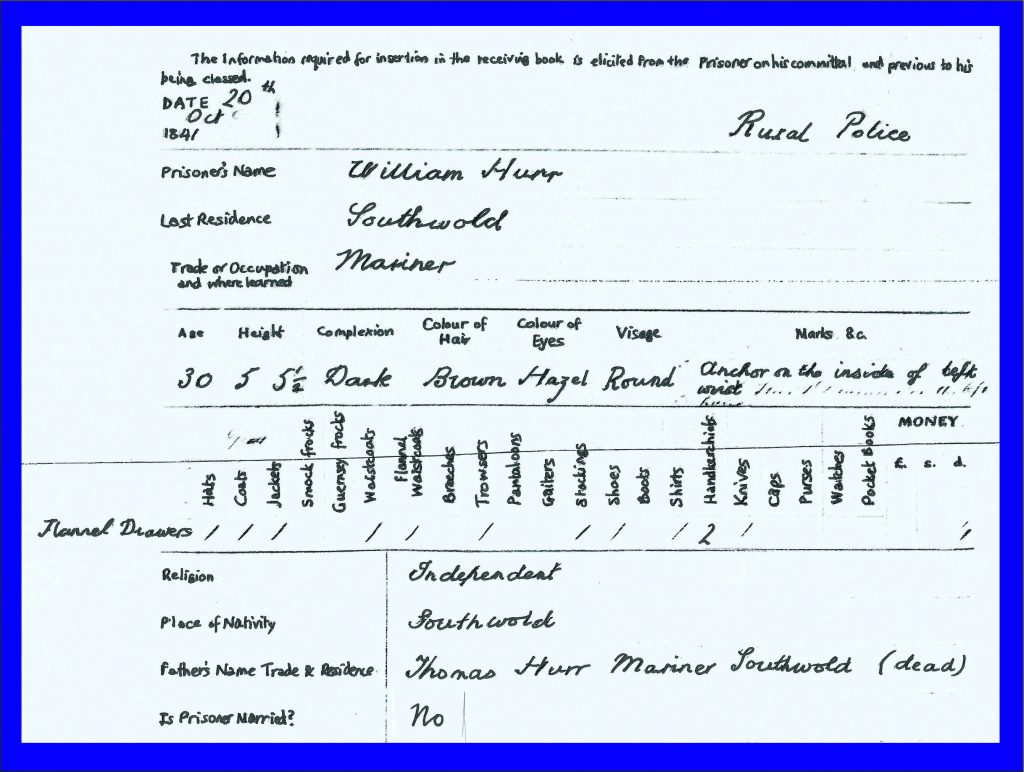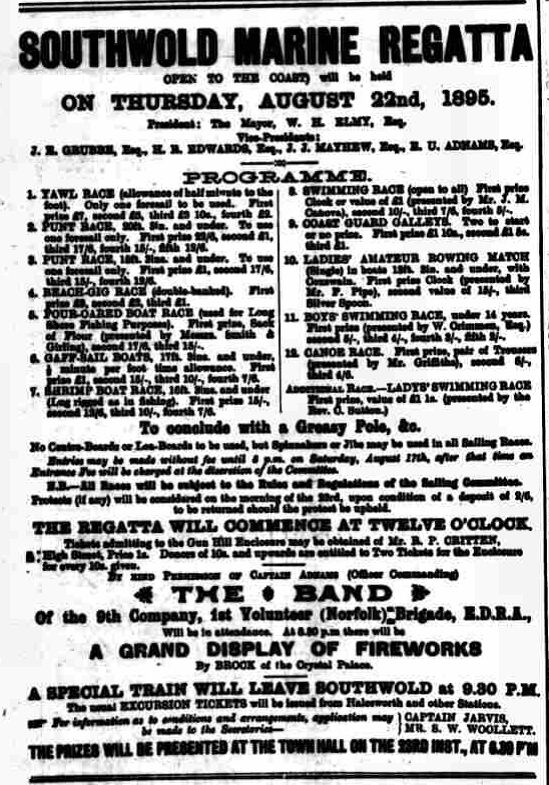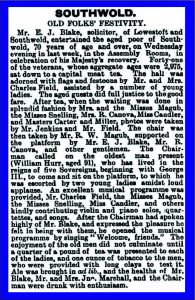
I first came across the stories of the Hurr family through a folk song collected by Ralph Vaughan Williams from one Ben Hurr: the coincidence of his name being a homophone of the chariot-driving hero Ben-Hur drew my attention immediately. Ben was a fisherman in Southwold on the Suffolk coast, and three of his brothers are known to have been singers too. Years of research have gradually revealed some more family stories, including some about their father, William Hurr (1811-1908), who, in his long life, lived through the reigns of five sovereigns of the English throne. William may have sung folksongs as well, though he died before Vaughan Williams arrived, and there’s no sign of anyone collecting folksongs in the area in his lifetime, so we will probably never know. However he did have some stories to tell.
William Hurr was born in Southwold in 1811, the oldest son of Thomas Hurr and Elizabeth Bedingfield. The family were of an independent religion – not specified, but probably Methodist – and pre the 1837 requirements for registration of births deaths and marriages, the records are a bit thin on the ground. William followed in the family occupation of fisherman, and at this time, the small sailing luggers and punts launched off the beach at Southwold, where the fishermen banded into beach companies to work together.
We find out what William looked like! … from a gaol receiving book
William’s first appearance in official documents is not auspicious: in 1839 he was imprisoned for one month for assaulting Sarah Bedingfield. Although this fact appears in the Suffolk Chronicle on 18th May, no further details are given. In a period when there were often many people with the same name, there are not many options for identifying this person, and it looks as if Sarah may well have been his aunt, his mother’s sister. It also seems likely that the same Sarah Bedingfield was admitted to the County Lunatic Asylum in 1849 and again in 1856, dying there in 1861. Whatever the circumstances, this looks like a sad scenario. This wasn’t the only time William expressed his anger or frustration through physical violence, as two years later, he and two younger brothers, John Bedingfield Hurr and Thomas Hurr, were convicted and gaoled for assaulting the newly-appointed Police constable in Southwold, John Parker. Again, no details of the assault are known, but for three brothers to attack him suggests a significant revolt against some action from Parker. In this case, the gaol receiving book (from Ipswich) gives interesting biographical details about William and his brothers. The photocopy of a photocopy in my possession is now very faded, so I have written over the top of it to make it more legible.

The receiving books describe all three brothers as having a dark complexion, brown hair, hazel eyes and a round ‘visage’. William, then aged 30, was 5’5½” tall and had an anchor on the inside of his left wrist. His religion was described as Independent, he had attended school in Southwold for two years and could read and write imperfectly and no occupation is given as mariner. At the time of his arrival in gaol, William had: flannel shirt & drawers, hat, coat, jacket, waistcoat, trousers, stockings, shoes, shirt, two handkerchieves and a knife. Note: not a guernsey or smock; he must have put on his best clothes for his court appearance. The two brothers convicted with him were John, aged 28, height 5’4” and Thomas aged 24, height 5’5”. John was noted as receiving parish relief. I have not traced either of these two in the 1841 census, but John was already married with a young child and Thomas married between October 1841 and January 1842 – more than likely on his release from gaol in November. William also got married shortly after this interlude, to Maria Watson in 1842. She was listed in the Hurr household in the 1841 census as well as at home with her mother in Lowestoft, so maybe they were already courting then.
Thankfully there are no further criminal activities evident in his subsequent life, but it was a life full of hardships.
Hard times
James Maggs 19th century diaries report on 17th April 1851: “Sale of Effects of Wm Hurr mariner- Under distress for Rent. Mrs J.F. Bokenham Landlady”. In the 1851 census carried out less than three weeks previous to this, the Hurrs were ‘near East St’. The landlady was not, as might be imagined, some well-to-do member of the landed gentry, but the wife of another mariner, Joseph Forster Bokenham. Despite apparently owning more than one property, when Bokenham died (drowned at sea in a fishing boat) on Christmas Eve, 1868 and probate was eventually sorted out nearly nine years later, his estate was worth less than £20.
At this point in their lives, William and Maria had three young children, and after moving round the corner to Victoria Street, they went on to have another nine children. Despite describing himself as “retired” in the 1881 census, he went on to be listed variously as a boat owner, fishing smack owner etc in commercial directories until 1892, aged 81.
 The boats were also used occasionally in competitions during regattas, and William’s family and boats had some successes: in those days, the fishing boats were at the heart of the event. In 1888 his son Sam was placed 5th in the 20ft punt class, in the Vigilant, and in 1889, the Ipswich Journal of 30th August reported the following result: “Punt race (20 feet and under): 1st prize of 25s. to Hurr’s Susannah; 3rd prize of 20s. to Hurr’s Vigilant – which nearly took second place.” That was to prove the zenith of the Hurrs competitive success – in 1893, the Vigilant came in 5th, still gaining a prize of 15 shillings and after that I cannot find any of William’s family listed: a likely reason is about to be revealed …
The boats were also used occasionally in competitions during regattas, and William’s family and boats had some successes: in those days, the fishing boats were at the heart of the event. In 1888 his son Sam was placed 5th in the 20ft punt class, in the Vigilant, and in 1889, the Ipswich Journal of 30th August reported the following result: “Punt race (20 feet and under): 1st prize of 25s. to Hurr’s Susannah; 3rd prize of 20s. to Hurr’s Vigilant – which nearly took second place.” That was to prove the zenith of the Hurrs competitive success – in 1893, the Vigilant came in 5th, still gaining a prize of 15 shillings and after that I cannot find any of William’s family listed: a likely reason is about to be revealed …
1893 was probably the worst year of William Hurr’s life: two sons, Sam, who had skippered the Vigilant in the 1888 regatta, and Tom, both died in a fishing accident, and just a month later his wife Maria died.
“The boat’s name was the Susannah, as fine a craft as ever was floated off the beach, and the crew, two of whom were sons of the owner, William Hurr, and Gabriel Peek, launched about six o’clock in the morning to haul their lines, and in the ordinary course would have returned between eleven and twelve. Not returning as expected, many an anxious eye scanned the deep for some trace of the boat bet saw none, and as the day were on all sorts of conjectures were made as to their whereabouts; some thinking that during the fog they had boarded some craft off the Barnard and had sailed with them; others that they bad boarded some steamer, or had put into Lowestoft. Unfortunately all surmise was futile, and the truth was briefly told in the telegram.”
The Susannah had been run down by a larger Lowestoft boat, and through a tragic set of circumstances, all hands were drowned.
After Maria’s death, William’s two unmarried daughters, Susannah and Annie, lived with him. It seems Susannah, the older, had long-term health problems (the newspaper report above said “at the present time his wife and daughter are confirmed invalids”) and it was Annie who ran the boarding houses they established at Caterer House, 39 Victoria Street and subsequently at 22 Corporation Road, where the three of them moved after Maria and Tom (who had been living home) died and Walter, the youngest son, married.
A grand old man

William outlived several of his children, and in the early 20th century found himself being feted as a grand old man of the community.
In a newspaper report in the Norwich Mercury on 23rd July, 1902, we find William being honoured as one of the oldest inhabitants at a “capital meat tea” held for the aged poor of the town. Ale and pipe tobacco was provided too, so it may indeed have been a festive occasion.
“The Chairman called on the oldest man present (William Hurr, aged 91), who has lived in the reigns of five Sovereigns, beginning with George III, to come and sit on the platform, to which he was escorted by two young ladies amidst loud applause.”
The report also mentions that two photographers were present including Frederick Jenkins (whose son A.B. Jenkins who edited several collections of his work) but so far I have not sighted any photographs taken on the occasion.
Frederick Jenkins not only took photographs, but also took an interest in writing down some of the memories from the older generation, including William at this time too, including the following tales of haunting and smuggling.
The first story is about either William’s father (Thomas Hurr 1787 to 1825) or his grandfather, who served in the Royal Navy and was held as a prisoner-of-war by the French for some time.
“A French lady fell in love with him and wanted him to marry her. He told her that he had a wife in England, but if, when he was set free he found she was dead, he would send word and then if the lady came over he would marry her. When peace was proclaimed and he returned to Southwold his wife was alive. The French lady however did not wait until she hear from him, but started for England shortly after he did. The vessel in which she sailed was lost with all hands. After this occurrence for a long time she used to “trouble” him, or rather, his wife, for the latter was constantly ill-treated, pulled out of bed and sometimes seriously hurt by unseen hands. This got to such a pitch that he was often obliged to go out of the house in the middle of the night to prevent his wife from being ill-used for, it was only when he was with her that things happened. One night after his wife had been annoyed by the “spirit” he went out of the house which was on South Green where he saw a large white cat sitting. He hit at it with a stick saying “Get out cat”. At this it suddenly reared up in the form of a beautiful white horse which Hurr followed as far as the Market Place where it vanished, and he found himself walking behind a funeral procession, coffin, mourners and all. He still followed this and it went slowly down Church Street as far as the Churchyard when it suddenly disappeared and he found himself alone.”
This was told to Fred Jenkins in 1903, as was this tale of smuggling, which William Hurr said happened when he was about 10, in 1821, when he was cabin boy on the Hope, of which Henry Sayers was the master.
“While the vessel was lying at Reydon Quay discharging a cargo, he was left on board alone to look after the ship. In the middle of the night he heard a noise on the quay, looking out of the fo-castle he saw one of the crew of a smuggling boat which had come into the harbour with 300 to 400 tubs hidden on board. The smuggler, John Spence, a Southwold man, told him to go below and he would be paid. Hurr did so and the “crop” was landed. Coming onto the deck the next morning Hurr found a stone “Betty” (bottle) of gin on deck. A similar bottle was left on another vessel ling alongside the quay. Hurr found on the quay a quantity of hoops and slings which he took home but left the bottle of gin on the vessel. The next day Mr Candler, the Custom House officer, came to Hurr’s home and asked him where he had got the slings and hoops. He told him Reydon Quay and was then asked if there were any tubs of liquor on the quay and he said he had not seen any. On the following day the smugglers’ boat was found on Blythburgh Flats. The crew had got clear away and successfully landed their cargo.”
A couple of years later William Hurr also contributed to Jenkins’ store of stories about a “Shrieking Woman”:
“Many people claimed to have heard unearthly shrieks which unfailingly portended wrecks or loss of life by drowning. W. Hurr’s father and mother [Thomas and Elizabeth, née Bedingfield] were coming home one night from the High Street to their house in East Street. When they were near the “Clinkums” (by the entrance to Church Street) his mother saw a figure and said to her husband, “Tom, what a beautiful dress that lady has on.” She had no sooner said this than the figure began shrieking and ran down the lane and vanished. The night before, Waters and two Rogers were drowned by their boat being sunk by a vessel.”
If he’d lived to be a hundred, we might know if William also sang songs, as the folksong collectors Ralph Vaughan Williams and George Butterworth paid a visit to the town in 1910 and noted down songs from three of his sons, William, Robert and Ben. George is also known to have been a singer, so it seems very likely their father was too, and they may even have learned some of their older songs, such as When Jones’ Ale was New from him.
Details about PC John Parker and the distraint of goods in 1851 were found in The Southwold Diary of James Maggs 1818-1876, edited by A.F. Bottomley, published in 1982. Maggs was a schoolmaster in the town and his diaries are a wonderful catalogue of everyday happenings. And to top it all, they are now available online in two volumes and can be downloaded as PDFs.
The ghost stories were printed in A Selection of Ghost Stories, Smuggling Stories and Poems connected with Southwold by A.B. Jenkins, published in 1986.
The advertisement for the Southwold Regatta in 1895 was in the Halesworth Times on 13th August.
Please note: Anyone wishing to cite this original research should credit it to Katie Howson and cite this website as the source. © Katie Howson, 2021.
Leave a Reply